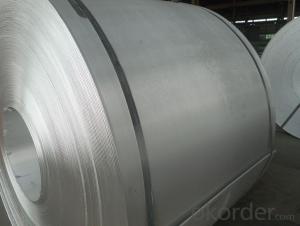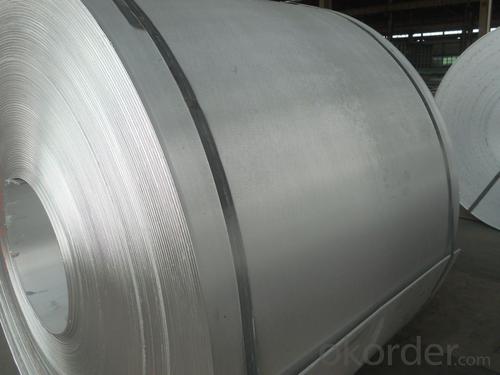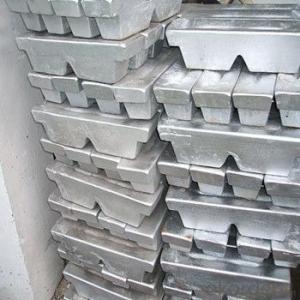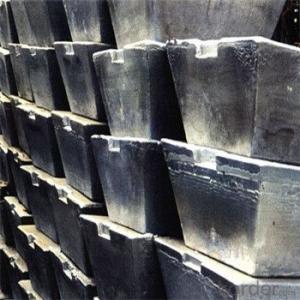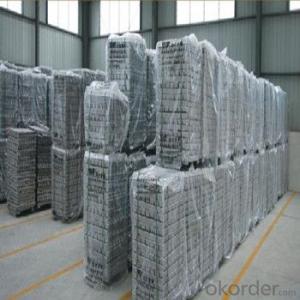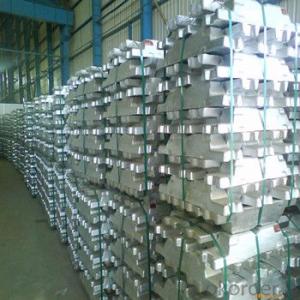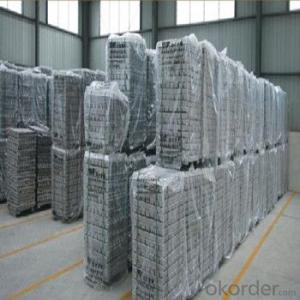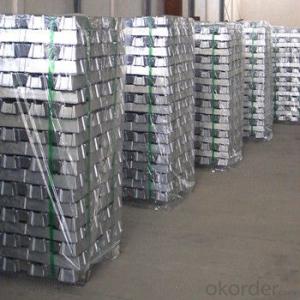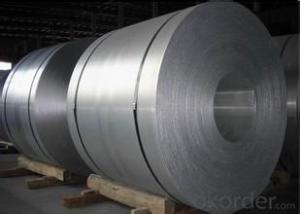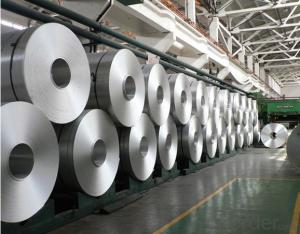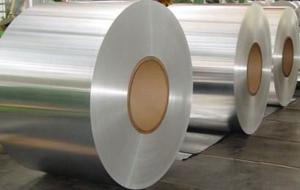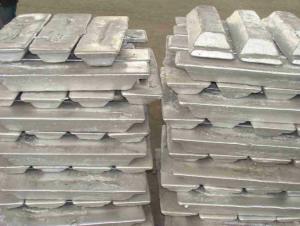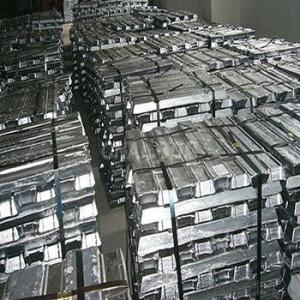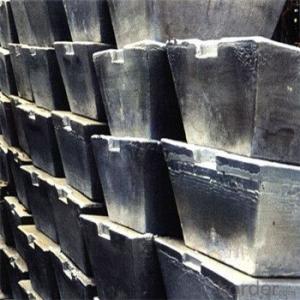Aluminum casting master coil AA1070=P1020 for melt
- Loading Port:
- Tianjin
- Payment Terms:
- TT OR LC
- Min Order Qty:
- 200 m.t.
- Supply Capability:
- 5000 m.t./month
OKorder Service Pledge
OKorder Financial Service
You Might Also Like
Aluminium alloys (or aluminum alloys; see spelling differences) are alloys in which aluminium (Al) is the predominant metal. The typical alloying elements are copper, magnesium, manganese, silicon, tin and zinc. There are two principal classifications, namely casting alloys and wrought alloys, both of which are further subdivided into the categories heat-treatable and non-heat-treatable. About 85% of aluminium is used for wrought products, for example rolled plate, foils and extrusions. Cast aluminium alloys yield cost-effective products due to the low melting point, although they generally have lower tensile strengths than wrought alloys. The most important cast aluminium alloy system is Al–Si, where the high levels of silicon (4.0–13%) contribute to give good casting characteristics. Aluminium alloys are widely used in engineering structures and components where light weight or corrosion resistance is required
Specification:
Alloy: AA1070
Temper: F
Thickness:6mm—100mm
Width: 900mm—2300mm (Can be slitted)
Inner Diameter: 508MM
Coil Weight: AS REQUIRED
Application: MELT FOR LINGOTE TO MAKE ALUMINUM COIL O PLATE
Features:
1. Excellent quality of products
2. Quick delivery
3. Best service to clients
4. BV,SGS avalible
5. No buckle o waveness
6. Tension leveling
7. Certificate of Origin
8. Form A,E,F
Packaging Detail:
Carton ,Wooden pallet with plastic protection packing ,standard seaworthy packing or as your request.
Production Capacity:
Annual Production capacity of 600,000 tons.
Products are exported to United States, Canada, U.A.E, Brazil, Mexico,Thailand, Vietnam, Nigeria etc, over 100 countries and regions all over the world.
Production Line:
CNBM aluminum production base is comprised of 18 aluminum annealers, 10 coil and foil mills, 4 continuous production lines, 2 hot rolling production line and 3 prepainted lines.
FAQ:
1. What is the form of payment?
Normally 30% TT, 100% L
/C AT SIGHT
2. Type of quotation?
FOB, CFR, CIF
3. Port of loading?
Any port in China
4. Delivery time?
30 day after client’s deposit
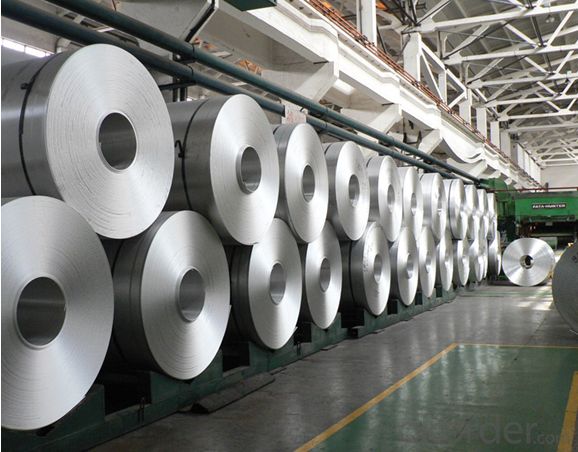
- Q: Where can I get aluminium ingots in cans?
- Because the cans of printing, transportation, recycling process, there will be a lot of impurities, so to purify.
- Q: What are the environmental benefits of using aluminum ingots in manufacturing?
- Using aluminum ingots in manufacturing processes brings about various environmental advantages. To begin with, aluminum is an extremely recyclable material that can be reused multiple times without losing its quality or properties. This means that the utilization of aluminum ingots reduces the necessity for extracting and processing raw materials, thereby conserving natural resources and decreasing energy consumption. Moreover, recycling aluminum emits significantly lower greenhouse gas emissions in comparison to the production of new aluminum from primary sources. Additionally, aluminum is both lightweight and durable, making it an ideal material for a wide range of applications. By incorporating aluminum ingots into manufacturing, one can contribute to the production of lighter and more fuel-efficient vehicles, thus reducing carbon emissions from transportation. Similarly, using lightweight aluminum components in construction can lead to energy savings during operation and a decreased overall carbon footprint of structures. Furthermore, aluminum exhibits excellent corrosion resistance, which extends the lifespan of products made with aluminum ingots. This prolonged durability reduces the frequency of replacements, resulting in less waste generation and a reduced demand for new materials. Through the utilization of aluminum ingots, manufacturers can actively contribute to a more circular economy by promoting the reuse and longevity of products. Moreover, aluminum ingots possess a lower melting point compared to many other metals, requiring less energy for processing and manufacturing. This reduced energy requirement translates into lower carbon dioxide emissions and overall energy consumption during the production process. Lastly, aluminum is non-toxic and non-magnetic, making it suitable for a wide array of applications, including food packaging and medical equipment. This ensures that products made with aluminum ingots do not pose health risks or disrupt sensitive equipment. In conclusion, the employment of aluminum ingots in manufacturing processes brings forth numerous environmental benefits. From its recyclability and lightweight properties to its corrosion resistance and low energy requirements, aluminum ingots contribute to the conservation of resources, decreased emissions, and a more sustainable and circular economy.
- Q: How are aluminum ingots used in the production of bicycles?
- The primary role of aluminum ingots in bicycle production is to serve as the main material for manufacturing bicycle frames. Aluminum, being a lightweight and durable metal, is an ideal choice for crafting frames that are both strong and lightweight. The process of producing bicycle frames involves first melting down aluminum ingots and then pouring the molten aluminum into molds to achieve the desired frame shape. After allowing the molten aluminum to cool and solidify, a solid ingot in the shape of the frame is formed. To further shape the aluminum ingots into tubes or other desired forms, various techniques such as extrusion or hydroforming are employed. These shaped tubes are then cut, welded, and joined together to create the overall frame structure of the bicycle. Aluminum ingots are preferred in bicycle manufacturing due to their exceptional strength-to-weight ratio. This characteristic allows for the creation of bicycles that are lighter in weight, making them easier to handle and maneuver, while still maintaining the necessary strength and rigidity for support. Moreover, aluminum ingots offer excellent resistance to corrosion, ensuring that the bicycle frames can endure harsh weather conditions and have a longer lifespan. This corrosion resistance is particularly significant for bicycles since they are frequently exposed to outdoor elements. Additionally, the use of aluminum ingots enables manufacturers to design frames with intricate and unique shapes, providing opportunities for customization and innovation in bicycle design. In conclusion, aluminum ingots are essential in bicycle production as they contribute to the creation of frames that are lightweight, durable, and resistant to corrosion. Their versatility and strength make them the preferred choice for manufacturers, ultimately enhancing the overall quality and performance of bicycles.
- Q: What type of spectrometer is used to analyze aluminium ingots?
- If you want to analyze the aluminum ingot, first of all depends on the purity of the ingot, how many, if 4, 9 or 5 more than 9 of the aluminum ingot, it is recommended not to begrudge the price, buy high-end equipment, or else trace elements can not be analyzed.
- Q: Aluminum sold alone, high benefit ah, why do aluminum ingot?
- No, aluminium powder is made of aluminium ingots
- Q: Can aluminum ingots be anodized?
- Aluminum ingots are capable of undergoing anodization. Anodization, an electrochemical procedure, yields a safeguarding oxide layer on the exterior of aluminum. This technique can be employed on aluminum ingots, sheets, or any other manifestations. Anodization boasts numerous advantages, including heightened resistance against corrosion, enhanced durability, and the potential to introduce color onto the surface. Moreover, the anodized layer enriches the aesthetic appeal of the aluminum and facilitates superior adhesion of paints or dyes. In summary, the anodization of aluminum ingots is a prevalent practice across diverse industries to augment both the properties and appearance of the metal.
- Q: What are the advantages of using aluminum ingots in electrical applications?
- Using aluminum ingots in electrical applications offers several benefits. To begin with, aluminum's lightweight composition makes it easier to handle and transport, which is particularly advantageous in electrical applications that require consideration of weight, such as power line construction or the manufacturing of electrical appliances. Additionally, aluminum boasts exceptional electrical conductivity, surpassing copper's conductivity by nearly double. This heightened conductivity enables efficient electricity transmission and minimizes energy losses within electrical systems. Furthermore, aluminum ingots possess a remarkable resistance to corrosion. When exposed to air, aluminum develops a protective oxide layer that safeguards against corrosion. Consequently, aluminum proves ideal for outdoor electrical applications that commonly encounter moisture or harsh weather conditions. Moreover, aluminum stands out as an incredibly recyclable material. It can be melted down and reused multiple times without compromising its properties. This not only diminishes the need for new raw materials through mining and extraction but also promotes the sustainability of electrical applications. Lastly, when compared to materials like copper or steel, aluminum ingots prove to be cost-effective. Aluminum is abundant in nature, and its extraction and processing entail relatively lower expenses, making it a more affordable choice for electrical applications. In conclusion, the advantages of utilizing aluminum ingots in electrical applications encompass their lightweight nature, exceptional electrical conductivity, corrosion resistance, recyclability, and cost-effectiveness. These characteristics establish aluminum as a preferred option in various electrical systems, contributing to enhanced efficiency, durability, and environmental sustainability.
- Q: Ask the relevant matters you master the scrap aluminum ingot casting of aluminum, which is divided into several, if the recycled scrap aluminum ingot casting to join what!
- The writing below seems reasonable, but it's too long.
- Q: What about aluminum ingot futures? How about the aluminum ingot price? Please help me!
- The price has gone up, the aluminum factory has done the selling, the inflation price has fallen, the cost support is not very active, I suggest you don't participate in the aluminum, want to speculate the metal, you have to participate in the zinc, ha ha
- Q: What are the advantages of using aluminum ingots in the production of automotive lightweighting solutions?
- There are several advantages of using aluminum ingots in the production of automotive lightweighting solutions. Firstly, aluminum is a lightweight material, which makes it ideal for reducing the overall weight of vehicles. By using aluminum ingots, manufacturers can significantly reduce the weight of various automotive components, such as body panels, engine parts, and structural elements. This reduction in weight leads to improved fuel efficiency, as lighter vehicles require less energy to accelerate and maintain speed. Additionally, it allows for better handling and maneuverability, enhancing the overall driving experience. Secondly, aluminum is a highly durable material that offers excellent strength-to-weight ratio. This means that even though it is lightweight, aluminum ingots provide sufficient strength and structural integrity to withstand the demands of everyday driving and ensure the safety of passengers. It can also resist corrosion, making it a suitable choice for automotive applications where exposure to harsh weather conditions or road salt is common. Another advantage of using aluminum ingots in automotive lightweighting is their versatility. Aluminum can be easily molded, shaped, and joined using various manufacturing techniques, allowing for the production of complex and intricate designs. This versatility allows manufacturers to create innovative automotive components that meet specific performance requirements without sacrificing weight reduction goals. Moreover, aluminum is a highly recyclable material, making it an environmentally friendly choice for automotive lightweighting solutions. The recycling process for aluminum consumes only a fraction of the energy required for primary production, resulting in fewer greenhouse gas emissions. This not only helps reduce the carbon footprint of the automotive industry but also promotes a more sustainable manufacturing process. Lastly, aluminum ingots offer cost advantages in the long run. While the initial production costs of aluminum components may be higher compared to traditional materials, such as steel, the overall lifecycle costs are often lower. The lightweight nature of aluminum reduces the demand on other vehicle systems, such as brakes and suspension, leading to potential savings in maintenance and replacement costs. Additionally, the recyclability of aluminum allows for the recovery and reuse of the material, reducing the need for new raw material extraction. In conclusion, the advantages of using aluminum ingots in the production of automotive lightweighting solutions include weight reduction, improved fuel efficiency, durability, versatility, environmental friendliness, and long-term cost savings. These benefits make aluminum a preferred choice for manufacturers aiming to enhance the performance, efficiency, and sustainability of modern vehicles.
Send your message to us
Aluminum casting master coil AA1070=P1020 for melt
- Loading Port:
- Tianjin
- Payment Terms:
- TT OR LC
- Min Order Qty:
- 200 m.t.
- Supply Capability:
- 5000 m.t./month
OKorder Service Pledge
OKorder Financial Service
Similar products
Hot products
Hot Searches
Related keywords
